Tackling Climate Change using Nature Based Solutions
This post is greater than 6 months old - links may be broken or out of date. Proceed with caution!

By Dr Juliet Staples, Senior Project Manager URBAN GreenUP
Liverpool is a front-runner city in the EU funded, Horizon 2020, URBAN GreenUP project, whose remit is to retrofit a range of nature-based solutions (NBS) across the city and to monitor them for their multiple environmental, social and economic benefits. The project team comprises of the City Council, the University of Liverpool and Mersey Forest and brings together city influence, academic challenge and green infrastructure expertise. Liverpool is partnered by 2 other European cities undertaking similar research and 5 global follower cities who will seek to replicate our NBS success.
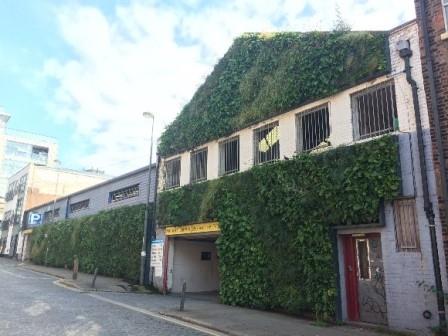
This 5-year and €4m pioneering research and innovation-led project of using nature to deliver ecosystem services in Liverpool has provided an opportunity for the city to visibly deliver on agendas for climate change adaptation, resilience and biodiversity.
Implementing the schemes has involved overcoming a range of (anticipated) operational and practical barriers, in addition to (unexpected), pandemic-related challenges. Despite covid delays to the installation of a few schemes and some monitoring data gaps during lockdown, Liverpool now has a range of NBS embedded into three newly emerging green corridor routes.
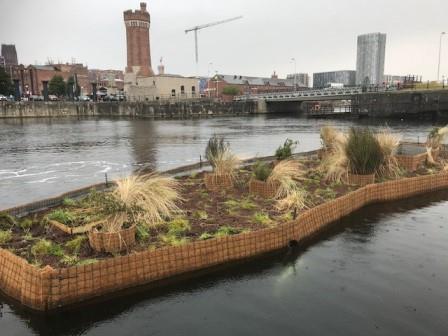
Two living green walls were completed in the summer of 2020. The first at 200m2 is over 65m long and on a shopping centre near the main bus station, where in addition to biodiversity, the wall is helping to contribute to local air quality improvements. The second green wall (pictured) is 130m2 and is tucked away on an urban back street, ever changing and fully accessible to pedestrians who can stop to pick strawberries from it in the summer. Early data hints at local air quality improvements, thermal regulation benefits for the building and biodiversity enhancements, which may potentially support a new bat foraging route. The wall has also become a local landmark for Instagram pictures and for many it now forms part of a regular route into the city. Recently it featured as a backdrop to a training commercial and was promoted on city region publications.
As a coastal city, Liverpool is a fitting location to trial one of the first saltwater floating ecosystem islands to enhance biodiversity in the docks (pictured). With the innovative features of raised planters, shallow freshwater trays, a suspended shingle shelf and an underwater reef made from empty oyster shells, the island ecosystem has attracted interest from Seattle, Melbourne, Romania and even a First American Indian tribe, who are keen to adapt it for growing traditional medicinal plants as an adaptation to climate change. Whilst the saltwater island has captured the attention of global cities, a smaller freshwater island in a nearby park lake has captured the hearts of the parks friends group, who regularly tweet about its development and bird visitors, as well as one of the park’s café operators, who has been inspired to generously sponsor additional NBS within the park. This smaller sister island is also providing the additional ecosystem service of improving water quality in the park lake by using the island’s reeds and grasses to remove excess nutrients from the water and reduce the likelihood of future toxic algal blooms.
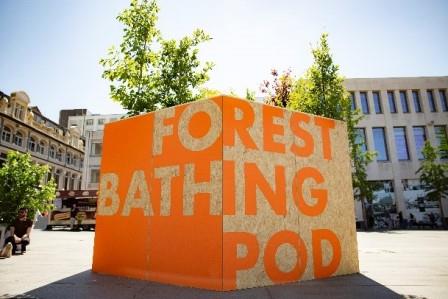
Trees in all their forms have formed the backbone of many NBS schemes in the city. Working with City Council colleagues in Highways and Drainage, tree sustainable urban drainage (SuD) systems have been installed into city highways schemes. Channelling excess highway surface water run off through the tree pits helps to ‘slow the flow’ and clean and reduce the final outflow to drain. In the same scheme, shade and cooling trees have been planted to help the city adapt to the urban heat island effect and filter trees line the edges of the main carriageways to help improve local air quality. Even trees in the pavement have benefitted by being planted into underground open cell structures, which both increase the capacity of available soil and accommodate the passage of essential underground utilities and communication cables.
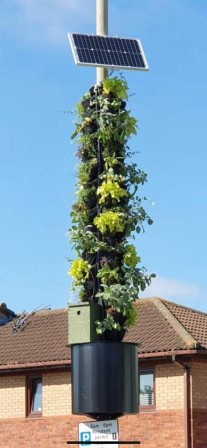
Innovation has been important for the project and the novelty of the mobile forest also grabbed local attention. The Mobile Forest (Forest Bathing Pod) is an open topped, hexagonal structure with trees and interior mirrored walls. Once inside, this creates the illusion of a never-ending forest - perfect for some ‘time out’ in a busy, urban city centre. Launched by the DEFRA tree Champion Sir William Worsley it attracted a lot of twitter traffic and positive feedback. This year the mobile forest is on its final tour to the good business festival and headlining at an autumn landscape conference before it ‘retires’ to a forest school in the city.
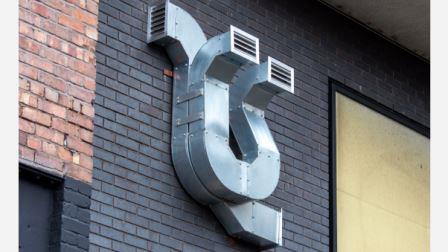
Experimentation with pollinators for enhanced biodiversity has included plans to hydroseed on hard and gravelled surfaces, to plant pollinators in shady spaces under tree canopies, as well as to create a green pollinator pavement in a high footfall location. Aspiring to improve sustainability practices, the project has sought to avoid herbicides and trial flame throwers to remove grass under tree canopies (with the obligatory 20 minute bug hunt to save any inhabitants before work starts!); an approach considered to offer better protection to both tree roots and ground nesting bees. In a handful of urban locations, the Smart Pollinator Pillar developed by Scotscape Ltd is being tested. These planted structures wrap around lamp post columns and come with a solar powered irrigation reservoir. Planting options can be customised for biodiversity (complete with mini insect homes), pollution (using plants with air purifying properties) or colour (with an array of different flowers).
Low cost innovation is woven through projects. There are plans to use sweet chestnut poles with bee nesting holes to replace traditional tree stakes; options to test different mulch types for weed suppression and (as part of the TV programme, ‘’Find it, Fix it, Flog it”), a city pollinator roof received a ‘bug hotel’ made out of an old sideboard. More recently, an art project has installed a habitat sculpture trail to provide city homes for animals. Some sculptures provide practical solutions, such as the use of twisted metal ducting to offer sparrow nesting areas, (which is pictured) while others prompt discussion and debate, such as the aspirational wire nesting platform for future city storks?
With the majority of the NBS now in place, the focus going forward is to analyse the data, quantify the benefits and build an evidence-based business case for the NBS. Each of the demonstrator schemes will tell a different story, but collectively they will continue to provide ecosystem services that help the city become more resilient and adapt to future climate change impacts.




Transformational projects like this generate many challenges, but they also leave important legacies and learning. Installing the new green and blue infrastructure in the city has brought colleagues and city stakeholders together, learning from each other and changing the way we approach future regeneration and development.
The URBAN GreenUP project has helped to lay the foundations for city nature-based solutions and will hopefully signpost the way forward.
More from Urban Green UP